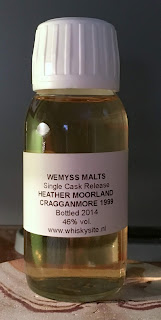Uigeadail has been one of Ardbeg's mainstays since it was introduced in 2003. Combining bourbon cask whisky with sherry casks whisky, it sought to incorporate the two characters without losing the distillery's trademark peat smoke.
While the initial batches were produced using sherry casks from the 70s, these inevitably ran low and were allocated for more expensive releases. Since then it has become increasingly clear that most or all of the spirit going into the mix is relatively young - when I went to the
Deconstructing the Dram tasting at the distillery in 2013 we were giving a sample from a six year old sherry cask as a representative component. This has raised questions about the quality and value of the expression now compared to when it was first released. Since I first tried Uigeadail from a miniature I've thought it is as relatively simple but still fairly good. So I wanted to give it another go to see where it stands today.

As with all Uigeadail, the whisky is aged in a mix of ex-bourbon and ex-sherry casks, then bottled at 54.2% without coloring or chill filtration.
Ardbeg Uigeadail (Unknown bottling date)
Nose: a little thin, moderate Ardbeg peat, background oak, a layer sherry, vanilla, cacao nibs, a touch of something floral. After adding a splash of water it becomes softer and flatter with more bourbon than sherry cask character.
Taste: rather hot throughout - malt and sherry sweetness up front, mild peat, vanilla, and oak near the back, a little flat. After dilution it becomes noticeably sweeter up front, but flatter and less overtly peated at the back.
Finish: hot, light oak and peat, sherry residue
Wow, what a letdown. Compared to the
miniature I tried in 2013, this comes off as thin and hot, without the depth of flavor I found before. There are some nice touches in the aromas, but they were difficult to find behind all of the hot alcohol. It feels like a bad batch made when they were running low on quality casks, whether sherry or bourbon. There's just not much going on here, definitely nothing that would make me want a whole bottle.
 |
Not my finest photography, but that's
what happens in a poorly lit bar |
Just to check if this was simply a bad sample, I also had a pour from a freshly opened bottle at the Highland Stillhouse. So hopefully this is more representative of what you'd be getting at the moment.
Ardbeg Uigeadail (L18)
Nose: thick sherry, a respectable level of smoky Ardbeg peat, cured meat, juicy raisins and berries, vanilla, herbal, cinnamon, roasted malt. After adding a few drops of water the sherry retreats to reveal more peat and it becomes saltier.
Taste: thick, sweet sherry throughout, hot but not overwhelmingly so, peat doesn't really come in until the finish. After dilution the malt shows up behind the sherry and the peat comes in earlier.
Finish: peat arrives, sherry residue, licorice, mild oak
Well, this is quite a bit more like it. While the flavors were a bit of a letdown, the nose had pretty much everything I would have expected at this point. Hits all of the sherry cask and Ardbeg notes with solid intensity. With that said, I still can't see myself paying more for this than for any other NAS sherry monster. There's just not enough complexity to justify a higher price point.
 Ardbeg An Oa
Ardbeg An Oa







